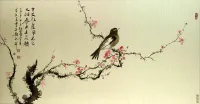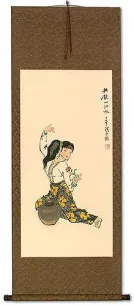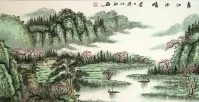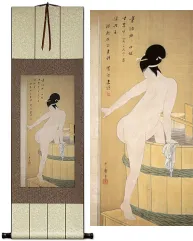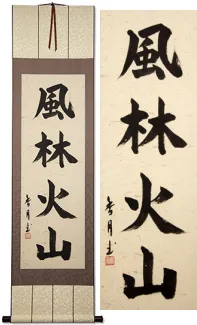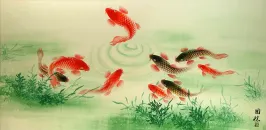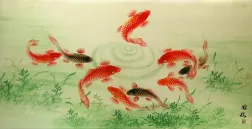Many custom options...
And formats...

The name Earth Fire Water Air in Chinese / Japanese...
Buy an Earth Fire Water Air calligraphy wall scroll here!
Personalize your custom “Earth Fire Water Air” project by clicking the button next to your favorite “Earth Fire Water Air” title below...
Five Elements
地水火風空 is the specifically-Japanese version of the five elements.
This is a little different than the ancient or original Chinese version.
The elements are written in this order:
1. Earth / Terra / Ground
2. Water
3. Fire
4. Wind / Air
5. Sky / Emptiness / Void / Ether
Note: This set of Kanji can also be romanized as “ji sui ka fuu kuu,” “jisuikafuukuu,” or “jisuikafuku.”
These can also be written in the order 地火風水空 (chi ka sui fuu kuu). Let me know when you place your order if you want the Kanji to be in this character order.
Earth Fire Water Air
This in-stock artwork might be what you are looking for, and ships right away...
Gallery Price: $322.00
Your Price: $178.88
Gallery Price: $144.00
Your Price: $79.88
Gallery Price: $240.00
Your Price: $98.88
Gallery Price: $400.00
Your Price: $138.88
Gallery Price: $400.00
Your Price: $138.88
Gallery Price: $121.00
Your Price: $66.88
Gallery Price: $200.00
Your Price: $122.88
Gallery Price: $72.00
Your Price: $39.88
Gallery Price: $72.00
Your Price: $39.88
Gallery Price: $72.00
Your Price: $39.88
Gallery Price: $448.00
Your Price: $248.88
Not the results for Earth Fire Water Air that you were looking for?
Below are some entries from our dictionary that may match your Earth Fire Water Air search...
| Characters If shown, 2nd row is Simp. Chinese |
Pronunciation Romanization |
Simple Dictionary Definition | ||||||||||||||||||||||||||||||||||||||||||||||||||||||||||||
五行 see styles |
wǔ xíng wu3 xing2 wu hsing gogyou / gogyo ごぎょう |
More info & calligraphy: Five Elements(1) (See 五大・ごだい・1) the five elements (in Chinese philosophy: wood, fire, earth, metal and water); the five phases; wu xing; (2) {Buddh} five practices of the Bodhisattvas; (3) (See 六信五行) the five pillars of Islam; (surname, given name) Gogyou The five lines of conduct. I. According to the 起信論 Awakening of Faith they are almsgiving; keeping the commandments; patience under insult; zeal or progress; meditation. II. According to the 涅槃經 Nirvana Sutra they are saintly or bodhisattva deeds; arhat, or noble deeds; deva deeds; children's deeds (i. e. normal good deeds of men, devas, and Hinayanists); sickness conditions, e. g. illness, delusion, etc.; — into all these lines of conduct and conditions a Bodhisattva enters. III. The five elements, or tanmātra— wood, fire, earth, metal, and water; or earth, water, ire, air, and ether (or space) as taught by the later Mahāyāna philosophy; idem 五大. |
||||||||||||||||||||||||||||||||||||||||||||||||||||||||||||
四大 see styles |
sì dà si4 da4 ssu ta shidai しだい |
More info & calligraphy: Shidai / Sida / Mahabhuta(1) {Buddh} the four elements (earth, water, fire, wind); (2) the human body; (3) Tao, heaven, earth and king mahābhūta, 四界; 四大界. The four elements of which all things are made; or the four realms; i. e. earth, water, fire, and wind (or air); they represent 堅, 濕, 煖, and 動 solid, liquid, heat, and motion; motion produces and maintains life. As 實 active or formative forces they are styled 四界 (四大界) ; as 假 passive or material objects they are 四大; but the 成實論 Satyasiddhi śāstra disputes the 實 and recognizes only the 假. |
||||||||||||||||||||||||||||||||||||||||||||||||||||||||||||
毒蛇 see styles |
dú shé du2 she2 tu she dokuja; dokuhebi どくじゃ; どくへび |
More info & calligraphy: Viperpoisonous snake; poisonous serpent A poisonous snake.; Poisonous snakes, the four elements of the body— earth, water, fire, wind (or air)— which harm a man by their variation, i. e. increase and decrease. Also, gold. |
||||||||||||||||||||||||||||||||||||||||||||||||||||||||||||
四大元素 see styles |
yondaigenso よんだいげんそ |
More info & calligraphy: Earth Fire Water Air |
||||||||||||||||||||||||||||||||||||||||||||||||||||||||||||
印 see styles |
yìn yin4 yin in いん |
to print; to mark; to engrave; a seal; a print; a stamp; a mark; a trace; image (1) stamp; seal; chop; (2) seal impression; seal; sealing; stamp; mark; print; (3) {Buddh} mudra (symbolic hand gesture); (4) ninja hand sign; (5) (abbreviation) (See 印度・インド) India; (surname) In mudrā; seal, sign, symbol, emblem, proof, assurance, approve; also 印契; 契印; 印相. Manual signs indicative of various ideas, e. g. each finger represents one of the five primary elements, earth, water, fire, air, and space, beginning with the little finger; the left hand represents 定 stillness, or meditation, the right hand 慧 discernment or wisdom; they have also many other indications. Also, the various symbols of the Buddhas and Bodhisattvas, e. g. the thunderbolt; cf. 因.; (度) The five Indias, or five regions of India, idem 五天竺 q. v. |
||||||||||||||||||||||||||||||||||||||||||||||||||||||||||||
大 see styles |
dài dai4 tai dai だい |
see 大夫[dai4 fu5] (pref,adj-na,n) (1) large; big; great; huge; vast; major; important; serious; severe; (prefix) (2) great; prominent; eminent; distinguished; (suffix) (3) -sized; as big as; the size of; (suffix noun) (4) (abbreviation) (See 大学・1) university; (5) large (e.g. serving size); large option; (6) (abbreviation) (See 大の月) long month (i.e. having 31 days); (given name) Yutaka Maha. 摩訶; 麼賀. Great, large, big; all pervading, all-embracing; numerous 多; surpassing ; mysterious 妙; beyond comprehension 不可思議; omnipresent 體無不在. The elements, or essential things, i.e. (a) 三大 The three all-pervasive qualities of the 眞如 q.v. : its 體, 相 , 用 substance, form, and functions, v. 起信論 . (b) 四大 The four tanmātra or elements, earth, water, fire, air (or wind) of the 倶舍論. (c)五大 The five, i.e. the last four and space 空, v. 大日經. (d) 六大 The six elements, earth, water, fire, wind, space (or ether), mind 識. Hīnayāna, emphasizing impersonality 人空, considers these six as the elements of all sentient beings; Mahāyāna, emphasizing the unreality of all things 法空, counts them as elements, but fluid in a flowing stream of life, with mind 識 dominant; the esoteric sect emphasizing nonproduction, or non-creation, regards them as universal and as the Absolute in differentiation. (e) 七大 The 楞嚴經 adds 見 perception, to the six above named to cover the perceptions of the six organs 根. |
||||||||||||||||||||||||||||||||||||||||||||||||||||||||||||
色 see styles |
shǎi shai3 shai shoku しょく |
(coll.) color; used in 色子[shai3 zi5] (counter) counter for colours; (female given name) Shiki rūpa, outward appearance, form, colour, matter, thing; the desirable, especially feminine attraction. It is defined as that which has resistance; or which changes and disappears, i. e. the phenomenal; also as 顯, 形 and 表色 colour and quality, form or the measurable, and mode or action. There are divisions of two, i. e. inner and outer, as the organs and objects of sense; also colour and form; of three, i. e. the visible object, e. g. colour, the invisible object, e. g. sound, the invisible and immaterial; of eleven, i. e. the five organs and five objects of sense and the immaterial object; of fourteen, the five organs and five objects of sense and the four elements, earth, water, fire, air. rūpa is one of the six bāhya-āyatana, the 六塵; also one of the five skandhas, 五蘊, i. e. the 色身. Keith refers to rūpa as 'material form or matter which is underived (no-utpādā) and which is derived (utpādā)', the underived or independent being the tangible; the derived or dependent being the senses, e. g. of hearing; most of their objects, e. g. sound; the qualities or faculties of feminity, masculinity, vitality; intimation by act and speech, space; qualities of matter, e. g. buoyancy and physical nutriment. |
||||||||||||||||||||||||||||||||||||||||||||||||||||||||||||
五智 see styles |
wǔ zhì wu3 zhi4 wu chih gochi ごち |
(place-name, surname) Gochi The five kinds of wisdom of the 眞言宗 Shingon School. Of the six elements 六大 earth, water, fire, air (or wind), ether (or space) 曇空, and consciousness (or mind 識 ), the first five form the phenomenal world, or Garbhadhātu, the womb of all things 胎藏界, the sixth is the conscious, or perceptive, or wisdom world, the Vajradhātu 金剛界, sometimes called the Diamond realm. The two realms are not originally apart, but one, and there is no consciousness without the other five elements. The sixth element, vijñāna, is further subdivided into five called the 五智 Five Wisdoms: (1) 法界體性智 dharmadhātu-prakṛti-jñāna, derived from the amala-vijñāna, or pure 識; it is the wisdom of the embodied nature of the dharmadhātu, defined as the six elements, and is associated with Vairocana 大日, in the centre, who abides in this samādhi; it also corresponds to the ether 空 element. (2) 大圓鏡智 adarśana-jñāna, the great round mirror wisdom, derived from the ālaya-vijñāna, reflecting all things; corresponds to earth, and is associated with Akṣobhya and the east. (3) 平等性智 samatā-jñāna, derived from mano-vijñāna, wisdom in regard to all things equally and universally; corresponds to fire, and is associated with Ratnasaṃbhava and the south. (4) 妙觀察智 pratyavekṣaṇa-jñāna, derived from 意識, wisdom of profound insight, or discrimination, for exposition and doubt-destruction; corresponds to water, and is associated with Amitābha and the west. (5) 成所作智 kṛtyānuṣṭhāna-jñāna, derived from the five senses, the wisdom of perfecting the double work of self-welfare and the welfare of others; corresponds to air 風 and is associated with Amoghasiddhi and the north. These five Dhyāni-Buddhas are the 五智如來. The five kinds of wisdom are the four belonging to every Buddha, of the exoteric cult, to which the esoteric cult adds the first, pure, all-refecting, universal, all-discerning, and all-perfecting. |
||||||||||||||||||||||||||||||||||||||||||||||||||||||||||||
六大 see styles |
liù dà liu4 da4 liu ta rokudai ろくだい |
{Buddh} the six elements (earth, water, fire, wind, void, and consciousness); (place-name) Rokudai The six great or fundamental things, or elements — earth; water; fire; wind (or air); space (or ether); and 識 mind, or perception. These are universal and creative of all things, but the inanimate 非情 are made only of the first five, while the animate 有情 are of all six. The esoteric cult represents the six elements, somewhat differently interpreted in the garbhadhātu and vajradhātu. Also 六大界. |
||||||||||||||||||||||||||||||||||||||||||||||||||||||||||||
六界 see styles |
liù jiè liu4 jie4 liu chieh rokkai |
The six elements: earth, water, fire, air (or wind), space, and mind; idem 六大. | ||||||||||||||||||||||||||||||||||||||||||||||||||||||||||||
四界 see styles |
sì jiè si4 jie4 ssu chieh shikai |
The four realms, idem 四大 earth, water, fire, and air. | ||||||||||||||||||||||||||||||||||||||||||||||||||||||||||||
四輪 四轮 see styles |
sì lún si4 lun2 ssu lun yonrin よんりん |
(can be adjective with の) four-wheeled The four wheels or circles: (1) 大地四輪 the four on which the earth rests, wind (or air), water, metal, and space. (2) Four images with wheels, yellow associated with metal or gold, white with water, red with fire, and black with wind. (3) The four dhyāni-buddhas, 金剛輪 Akṣobhya; 寳輪 Ratnasaṃbhava; 法輪 Amitābha; 羯磨輪 Amoghasiddhi. (4) Also the four metals, gold, silver, copper, iron, of the cakravartin kings. |
||||||||||||||||||||||||||||||||||||||||||||||||||||||||||||
地大 see styles |
dì dà di4 da4 ti ta chihiro ちひろ |
(personal name) Chihiro Earth as one of the 四大 four elements, 地 earth, 水大 water, 火大 fire, and 風大 air (i. e. air in motion, wind); to these 空大 space (Skt. ākāśa) is added to make the 五大 five elements; 識 vijñāna, perception to make the six elements; and 見 darśana, views, concepts, or reasonings to make the seven elements. The esoteric sect use the five fingers, beginning with the little finger, to symbolize the five elements. |
||||||||||||||||||||||||||||||||||||||||||||||||||||||||||||
字輪 字轮 see styles |
zì lún zi4 lun2 tzu lun jirin |
The wheel, rotation, or interchange of words for esoteric purposes, especially the five Sanskrit signs adopted for the five elements, earth, water, fire, air, space. | ||||||||||||||||||||||||||||||||||||||||||||||||||||||||||||
已生 see styles |
yǐ shēng yi3 sheng1 i sheng ishō |
部多 bhūta. Become, the moment just come into existence, the present moment; being, existing; a being, ghost, demon; a fact; an element, of which the Hindus have five— earth, water, fire, air, ether; the past. | ||||||||||||||||||||||||||||||||||||||||||||||||||||||||||||
駄都 see styles |
tuó dōu tuo2 dou1 t`o tou to tou |
dhātu, intp. by 界 field, area, sphere; 體 embodiment, body, corpus; 性nature, characteristic. It means that which is placed or laid; a deposit, foundation, constituent, ingredient, element; also a śarīra, or relic of Buddha The two dhātus are the conditioned and unconditioned, phenomenal and noumenal; the three are the realms of desire, of form, and of the formless; the four are earth, water, fire, and air; the six add space and intelligence; the eighteen are the twelve āyatanas, with six sensations added. | ||||||||||||||||||||||||||||||||||||||||||||||||||||||||||||
五輪觀 五轮观 see styles |
wǔ lún guān wu3 lun2 guan1 wu lun kuan gorin kan |
五輪三摩地 A meditation of the esoteric school on the five elements, earth, water, fire, air, and space, with their germ-words, their forms (i. e. square, round, triangular, half-moon, and spherical), and their colors (i. e. yellow, white, red, black, and blue). The five wheels also represent the Five Dhyāni-Buddhas, v. 五智. The object is that 五輪成身 the individual may be united with the five Buddhas, or Vairocana. | ||||||||||||||||||||||||||||||||||||||||||||||||||||||||||||
倶有因 see styles |
jù yǒu yīn ju4 you3 yin1 chü yu yin kuu in |
sahabhūhetu, mutual causation, the simultaneous causal interaction of a number of things, e.g. earth, water, fire, and air. | ||||||||||||||||||||||||||||||||||||||||||||||||||||||||||||
四毒蛇 see styles |
sì dú shé si4 du2 she2 ssu tu she |
Four poisonous snakes (in a basket), e. g. the four elements, earth, water, fire, and air, of which a man is formed. | ||||||||||||||||||||||||||||||||||||||||||||||||||||||||||||
衞世師 衞世师 see styles |
wèi shì shī wei4 shi4 shi1 wei shih shih Eiseishi |
Vaiśeṣika; derived from viśeṣa, characteristic, individuality, particularity or individual essence. M.W. Also 鞞世師 (or 鞞思迦); 吠世史迦; 勝論宗 An atomistic school founded by Kaṇāda. Like the Saṅkhya philosophy it taught a dualism and an endless number of souls, also by its doctrine of particularity or individual essence maintained 'the eternally distinct or sui generis nature of the nine substances' (see below), 'of which the first five including mind are held to be atomic.' M.W. The interaction of these with the six mentioned below produces cosmic evolution. It chiefly occupied itself, like the orthodox Nyāya philosophy, with the theory of knowledge, but it differed by distinguishing only six categories of cognition 六諦, viz. substance, quality, activity, species, distinction, and correlation, also a seventh of non-existence, and nine substances possessed of qualities, these 九陰 being: the five elements, air, fire, water, earth, ether, together with time, space, spirit (manas), and soul (ātman). Cf. Keith, Indian Logic and Atomism, and Dasgupta, History of Indian Philosophy. | ||||||||||||||||||||||||||||||||||||||||||||||||||||||||||||
陀羅驃 陀罗骠 see styles |
tuó luó biāo tuo2 luo2 biao1 t`o lo piao to lo piao darahyō |
dravya, the nine 'substances' in the nyāya philosophy, earth, water, fire, air, ether 空, time, space 方, soul 神, and mind 意. | ||||||||||||||||||||||||||||||||||||||||||||||||||||||||||||
五智如來 五智如来 see styles |
wǔ zhì rú lái wu3 zhi4 ru2 lai2 wu chih ju lai gochi nyorai |
五智五佛; 五佛; 五如來 The five Dhyāni-Buddhas, or Wisdom-Tathāgatas of the Vajradhātu 金剛界, idealizations of five aspects of wisdom; possibly of Nepalese origin. The Wisdom Buddha represents the dharmakāya or Buddha-mind, also the Dharma of the triratna, or trinity. Each evolves one of the five colours, one of the five senses, a Dhyani-bodhisattva in two forms onegracious, the other fierce, and a Mānuṣi-Buddha; each has his own śakti, i. e. feminine energy or complement; also his own bīja, or germ-sound 種子or 印 seal, i. e. 眞言 real or substantive word, the five being for 大日 aṃ, for 阿閦 hūṃ, for 寶生 ? hrīḥ, for 彌陀 ? aḥ, for 不 空 ? āḥ. The five are also described as the emanations or forms of an Ādi-Buddha, Vajrasattva; the four are considered by others to be emanations or forms of Vairocana as theSupreme Buddha. The five are not always described as the same, e. g. they may be 藥師 (or 王) Bhaiṣajya, 多寶 Prabhūtaratna, Vairocana, Akṣobhya, andeither Amoghasiddhi or Śākyamuni. Below is a classified list of the generally accepted five with certain particulars connected with them, butthese differ in different places, and the list can only be a general guide. As to the Dhyāni-bodhisattvas, each Buddha evolves three forms 五佛生五菩薩, 五金剛, 五忿怒, i. e. (1) a bodhisattva who represents the Buddha's dharmakāya, or spiritual body; (2) a vajra ordiamond form who represents his wisdom in graciousness; and (3) a fierce or angry form, the 明王 who represents his power against evil. (1) Vairocanaappears in the three forms of 轉法輪菩薩 Vajra-pāramitā Bodhisattva, 遍照金剛 Universally Shining Vajrasattva, and 不動明王 Ārya-Acalanātha Rāja; (2) Akṣobhya's three forms are 虛空藏 Ākāśagarbha, 如意 complete power, and 軍荼利明王 Kuṇḍalī-rāja; (3 ) Ratnasaṃbhava's are 普賢 Samantabhadra, 薩埵Sattvavajra, and 孫婆 or 降三世明王 Trailokyavijayarāja; (4) Amitābha's are 觀世音 Avalokiteśvara, 法金剛 Dharmarāja, and 馬頭明王 Hayagrīva, thehorse-head Dharmapāla; (5) Amoghasiddhi's are 彌勒 Maitreya, 業金剛Karmavajra, and 金剛夜叉 Vajrayakṣa. The above Bodhisattvas differ from those in the following list:
Arrival of the five wise Buddhas |
||||||||||||||||||||||||||||||||||||||||||||||||||||||||||||
五輪六大 五轮六大 see styles |
wǔ lún liù dà wu3 lun2 liu4 da4 wu lun liu ta gorin rokudai |
The five are the 五大 five elements, to which the sixth 大 is added, i. e. the six elements, earth, water, fire, air and space, and 識 intelligence or mind. | ||||||||||||||||||||||||||||||||||||||||||||||||||||||||||||
法身體性 法身体性 see styles |
fǎ shēn tǐ xìng fa3 shen1 ti3 xing4 fa shen t`i hsing fa shen ti hsing hōshin taishō |
The embodiment, totality, or nature of the dharmakāya. In Hīnayāna the Buddha-nature in its 理 or absolute side is described as not discussed, being synonymous with the 五分 five divisions of the commandments, meditation, wisdom, release, and doctrine, 戒, 定, 慧, 解脫, and 知見. In the Mahāyāna the 三論宗 defines the absolute or ultimate reality as the formless which contains all forms, the essence of being, the noumenon of the other two manifestations of the triratna. The 法相宗 defines it as (a) the nature or essence of the whole triratna; (b) the particular form of the Dharma in that trinity. The One-Vehicle schools represented by the 華嚴宗, 天台, etc., consider it to be the bhūtatathatā, 理 and 智 being one and undivided. The Shingon sect takes the six elements-earth, water, fire, air, space, mind-as the 理 or fundamental dharmakāya and the sixth, mind, intelligence, or knowledge, as the 智 Wisdom dharmakāya. | ||||||||||||||||||||||||||||||||||||||||||||||||||||||||||||
阿卑羅吽欠 阿卑罗吽欠 see styles |
ā bēi luó hǒu qiàn a1 bei1 luo2 hou3 qian4 a pei lo hou ch`ien a pei lo hou chien a hi ra ku ketsu |
a-vi-ra-hūm-kham, (or āḥ-vi-ra-hūm-kham the Shingon 'true word' or spell of Vairocana, for subduing all māras, each sound representing one of the five elements, earth, water, fire, wind (or air), and space (or ether). Also, 阿毘羅吽欠 (or 阿尾羅吽欠 or阿尾羅吽劍 or阿毘羅吽劍); 阿味囉 M020011欠. | ||||||||||||||||||||||||||||||||||||||||||||||||||||||||||||
阿縛羅訶佉 阿缚罗诃佉 see styles |
ā fú luó hē qiā a1 fu2 luo2 he1 qia1 a fu lo ho ch`ia a fu lo ho chia a ba ra ka ka |
a-va-ra-ha-kha, a spell uniting the powers respectively of earth, water, fire, air, and space. | ||||||||||||||||||||||||||||||||||||||||||||||||||||||||||||
Variations: |
genso げんそ |
(1) (元素 only) {chem} (See 化学元素) element; chemical element; (2) (classical) element (e.g. earth, water, air, fire); (3) (archaism) origin; source | ||||||||||||||||||||||||||||||||||||||||||||||||||||||||||||
Variations: |
genso げんそ |
(1) (元素 only) {chem} (See 化学元素) element; chemical element; (2) (classical) element (e.g. earth, water, air, fire); (3) (archaism) origin; source |
The following table may be helpful for those studying Chinese or Japanese...
| Title | Characters | Romaji (Romanized Japanese) | Various forms of Romanized Chinese | |
| Five Elements | 地水火風空 地水火风空 | chi sui ka fuu kuu chisuikafuukuu chi sui ka fu ku | ||
| Earth Fire Water Air | 四大元素 | yondaigenso | ||
| In some entries above you will see that characters have different versions above and below a line. In these cases, the characters above the line are Traditional Chinese, while the ones below are Simplified Chinese. | ||||
Successful Chinese Character and Japanese Kanji calligraphy searches within the last few hours...


